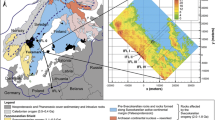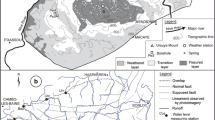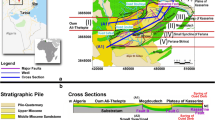Abstract
On-going geological disposal programs for spent nuclear fuel have generated strong demands for investigation and characterization of deep-lying groundwater systems. Because of the long time scales for which radiological safety needs to be demonstrated in safety assessment applications, an analysis of the hydrogeological performance of the geosphere system during glacial climate conditions is needed. Groundwater flow at depth in crystalline rock during the passage of an ice-sheet margin is discussed based on performed groundwater-flow modeling of two bedrock sites, Forsmark and Laxemar, in the Fennoscandian Shield, Sweden. The modeled ice sheet mimics the Weichselian ice sheet during its last major advance and retreat over northern Europe. The paper elaborates and analyzes different choices of top boundary conditions at the ice sheet–subsurface interface (e.g. ice-sheet thickness and ice-margin velocity) and in the proglacial area (presence or lack of permafrost) and relates these choices to available groundwater-flow-model hydraulic output and prevailing conceptual hydrogeochemical models of the salinity evolution at the two sites. It is concluded that the choice of boundary conditions has a strong impact on results and that the studied sites behave differently for identical boundary conditions due to differences in their structural-hydraulic properties.
Résumé
Les programmes en cours de stockage géologique de combustible nucléaire usé ont généré des demandes fortes d’investigation et de caractérisation des systèmes hydrogéologiques profonds. En raison des échelles de temps longues sur lesquelles la sécurité radiologique doit être démontrée, dans le cadre des demandes d’évaluation de la sécurité, une analyse du fonctionnement hydrogéologique de la géosphère dans les conditions d’un climat glaciaire est nécessaire. L’écoulement souterrain profond dans une roche cristalline pendant le passage du front de calotte glaciaire est discuté sur la base d’un modèle mis en œuvre sur deux sites de substrat, du Bouclier Fenno-scandien, Forsmark et Laxemare, Suède. La modélisation simule la calotte glaciaire du Weichselien durant sa dernière avancée importante et son retrait à travers l’Europe du Nord. L’article considère et analyse différentes conditions aux limites supérieures, à l’interface de la base de la calotte glaciaire (exemple épaisseur de la couverture de glace et vitesse du front glaciaire) et dans le domaine pro-glaciaire (présence ou absence de pergélisol) et corrèle ces cas aux résultats du modèle d’écoulement hydraulique souterrain disponible et aux modèles hydrogéochimiques conceptuels prévalants d’évolution de la salinité sur les deux sites. On conclut que le choix des conditions aux limites a un fort impact sur les résultats et que les sites étudiés se comportent différemment pour des conditions aux limites identiques en raison de propriétés hydrauliques structurelles différentes.
Resumen
Los programas actuales de disposición geológica para el combustible nuclear utilizado generaron fuertes demandas para la investigación y caracterización de los sistemas de aguas subterráneas yacentes en profundidad. Debido a las largas escalas de tiempo, la seguridad radiológica necesita ser demostrada con la evaluación de aplicaciones seguras, siendo necesario un análisis de la performance hidrogeológica del sistema de la geósfera durante las condiciones climáticas glaciales. Se discute el flujo de agua subterránea en profundidad en una roca cristalina durante el pasaje de un límite de capa de hielo basado en el modelado del flujo de agua subterránea realizado en dos sitios de roca de basamento. Forsmark y Laxemar, en el Escudo Fennoscandian, Suecia. La capa de hielo modelada simula la capa de hielo de Weichselian durante su último mayor avance y retroceso sobre el norte de Europa. El trabajo elabora y analiza diferentes opciones de las condiciones del contorno superior en la interfase capa de hielo - subsuperficie (por ejemplo el espesor de la capa de hielo y la velocidad del límite del hielo) y en el área proglacial (presencia o ausencia de permafrost) y relaciona estas opciones con la salida hidráulica del modelo de flujo subterráneo disponible y los modelos hidrogeoquímicos conceptuales prevalentes de la evolución de la salinidad en los dos sitios. Se concluye que la opción de las condiciones de contorno tiene un impacto fuerte sobre los resultados y que los sitios estudiados se comportan de manera diferente para condiciones de contorno idénticas debido a las diferencias en sus propiedades estructurales e hidráulicas.
摘要
核废料的地质处理工程需要深入的研究刻画深层地下水系统。由于在安全评价中需要证明核辐射在长时间尺度上是安全的,所以在冰期气候条件下的岩石圈的水文地质分析是需要的。基于在瑞典芬诺斯堪的亚地盾Forsmark 和 Laxemar两处基岩中地下水流的模拟,对冰盖边缘下结晶岩深处地下水流进行了讨论。模拟的冰盖模仿了遍布北欧的处于最后的主要的增长和衰退期的Weichselian冰盖。本文详细的阐述和分析 了冰盖地下界面(如冰盖厚度和冰盖边缘流速)和冰前区域(存在或缺乏多年冻土)的上边界条件的不同选择,并把这些选择与合适的地下水流模型的液压输出和Forsmark 、 Laxemar两处盐分演化的主要水文地球化学概念模型联系起来。结果表明,边界条件的选择对结果有显著的影响;由于构造水力性质的不同,在同一边界条件下Forsmark 、 Laxemar两研究区表现出不同的行为。
Resumo
Os correntes programas de armazenamento geológico de combustível nuclear têm gerado fortes necessidades de investigação e caraterização de sistemas de água subterrânea profundos. Devido às longas escalas de tempo, em que as necessidades de segurança radiológica têm de ser demonstradas nas aplicações de controlo de segurança, é necessária uma análise do desempenho hidrogeológico do sistema da geosfera durante condições climáticas glaciais. É discutido o fluxo de água subterrânea em profundidade em rochas cristalinas durante a passagem de uma margem de um manto de gelo, com base na modelação de fluxo de água subterrânea em dois locais de bed-rock, Forsmark e Laxemar, no Escudo Fenoscandinavo, na Suécia. O manto de gelo modelado mimetiza o manto Weichseliano durante o seu maior desenvolvimento e recuo sobre a Europa do norte. O artigo elabora e analisa diferentes seleções das condições de fronteira de topo, na interface do manto de gelo com a subsuperfície (e.g. espessura do manto de gelo e velocidade da margem do gelo) e na área pró-glacial (presença ou falta de permafrost) e relaciona estas escolhas com os resultados disponíveis através dos modelos hidráulicos de fluxo e dos modelos hidrogeoquímicos concetuais da evolução da salinidade nos dois locais. Conclui-se que a escolha das fronteiras tem um forte impacte nos resultados e que os locais de estudo se comportam de modo diferente para idênticas condições de fronteira, devido a diferenças nas suas propriedades hidráulico-estruturais.










Similar content being viewed by others
References
Anderson MP, Woessner WW (1992) Applied groundwater modeling: simulation of flow and advective transport. Academic, San Diego, CA, 381 pp
Bense VF, Person MA (2008) Transient hydrodynamics within intercratonic sedimentary basins during glacial cycles. J Geophys Res 113(F04005):17. doi:10.1029/2007JF000969
Boulton GS, Payne A (1993) Simulation of the European ice sheet through the last glacial cycle and prediction of future glaciation. SKB TR-93-14, Svensk Kärnbränslehantering, Stockholm
Boulton GS, Caban PE, Van Gijssel K (1995) Groundwater flow beneath ice sheets: part I, large scale patterns. Quat Sci Rev 14:545–562
Boulton GS, Caban P, Hulton N (1999) Simulations of the Scandinavian ice sheet and its subsurface conditions. SKB R-99-73. Svensk Kärnbränslehantering, Stockholm
Boulton GS, Lunn RJ, Vidstrand P, Zatsepin S (2007) Subglacial drainage by groundwater-channel coupling, and the origin of esker systems: part II, theory and simulation of a modern system. Quat Sci Rev 26:1091–1105
Bremeer CW, Clark PU, Haggerty R (2002) Modelling the subglacial hydrology of the late Pleistocene Lake Michigan Lobe, Laurentide Ice Sheet. GSA Bull 114(6):665–674
Burt TP, Williams PJ (1976) Hydraulic conductivity in frozen soils. Earth Surf Process 1(4):349–360
Carlsson AE, Jenson JW, Clark PU (2007) Modeling the subglacial hydrology of the James Lobe of the Laurentide Ice Sheet. Quat Sci Rev 26(9–10):1384–1397
Chan T, Christiansson R, Boulton GS, Ericsson LO, Hartikainen J, Jensen RM, Ivars MD, Stanchell WF, Vidstrand P, Wallroth T (2005) DECOVALEX III BMT3/BENCHPAR WP4: the thermo-hydro-mechanical responses of a glacial cycle and their potential implication for deep geological disposal of nuclear fuel waste in a fractured crystalline rock mass. Int J Rock Mech Min Sci 42(5-6):805–827
Cohen D, Person M, Wang P, Gable WC, Hutchinson D, Marksamer A, Dugan B, Kooi H, Lizarralde D, Evans LR, Day-Lewis DF, Lane WJ Jr (2010) Origin and extent of fresh paleowaters on the Atlantic Continental Shelf, USA. Ground Water 48(1):143–158
Cufey KM, Paterson WSB (2010) The physics of glaciers, 4th edn. Pergamon, Oxford, 693 pp
Das SB, Joughin I, Behn MD, Howat IM, King M, Lizarralde D, Bhatia MP (2008) Fracture propagation to the base of the Greenland ice sheet during supraglacial lake drainage. Science 320(5877):778–781. doi:10.1126/science.1153360
Flowers GE, Clarke GKC (2002) A multicomponent coupled model of glacier hydrology: 1. theory and synthetic examples. J Geophys Res 107(B11):2287
Follin S (2008) Bedrock hydrogeology Forsmark. Site descriptive modelling, SDM-Site Forsmark. SKB R-08-95, Svensk Kärnbränslehantering, Stockholm, 163 pp
Follin S, Svensson U (2003) On the role of mesh discretisation and salinity for the occurrence of local flow cells: results from a regional-scale groundwater flow model of Östra Götaland. R-03-23, Svensk Kärnbränslehantering, Stockholm
Follin S, Stephens MB, Laaksoharju M, Nilsson A-C, Smellie JAT, Tullborg E-L (2008) Modelling the evolution of hydrochemical conditions in the Fennoscandian Shield during Holocene time using multidisciplinary information. Appl Geochem 23(7):2004–2020
Glamheden R, Fredriksson A, Persson L, Röshoff K, Karlsson J, Bohlin H, Lindberg U, Hakami H, Hakami E, Johansson M (2007) Rock mechanics Forsmark, Site descriptive modelling Forsmark stage 2.2. SKB R-07-31, Svensk Kärnbränslehantering, Stockholm, 277 pp
Haggerty R, Gorelick SM (1995) Multiple-rate mass transfer for modelling diffusion and surface reactions in media with pore-scale heterogeneity. Water Resour Res 31:2383–2400
Hakami E, Fredriksson A, Lanaro F, Wrafter J (2008) Rock mechanics Laxemar: site descriptive modelling SDM-Site Laxemar. SKB R-08-57, Svensk Kärnbränslehantering, Stockholm
Harper J, Hubbard A, Ruskeeniemi T, Claesson-Liljedahl L, Lehtinen A, Booth A, Brinkerhoff D, Drake H, Dow C, Doyle S, Engström J, Fitzpatrick A, Frape S, Henkemans E, Humphrey N, Johnson J, Jones G, Joughin I, Klint KE, Kukkonen I, Kulessa B, Landowski C, Lindbäck K, Makahnouk M, Meierbachtol T, Pere T, Pedersen K, Pettersson R, Pimentel S, Quincey D, Tullborg E-L, van As D (2011) The Greenland analogue project. Yearly report 2010, SKB R-11-23, Svensk Kärnbränslehantering, Stockholm
Hartikainen J, Kouhia R, Wallroth T (2010) Permafrost simulations at Forsmark using a 2D thermo-hydro-chemical model. SKB TR-09-17, Svensk Kärnbränslehantering, Stockholm
Hermansson T, Stephens MB, Corfu F, Andersson J, Page L (2007) Penetrative ductile deformation and amphibolite-facies metamorphism prior to 1851 Ma in the western part of the Svecofennian orogen, Fennoscandian shield. Precambrian Res 153:29–45
Hermansson T, Stephens MB, Corfu F, Page L, Andersson J (2008a) Migratory tectonic switching, western Svecofennian orogen, central Sweden: constraints from U/Pb zircon and titanite geochronology. Precambrian Res 161:250–278
Hermansson T, Stephens MB, Page L (2008b) 40Ar/39Ar hornblende geochronology from the Forsmark area in central Sweden: constraints on late Svecofennian cooling, ductile deformation and exhumation. Precambrian Res 167:303–315
Hökmark H, Lönnqvist M, Fälth B (2010) THM-issues in repository rock. Thermal, mechanical, thermo-mechanical and hydro-mechanical evolution of the rock at the Forsmark and Laxemar sites. SKB TR-10-23, Svensk Kärnbränslehantering, Stockholm
Jansson P, Näslund J-O, Rodhe L (2007) Ice sheet hydrology: a review. SKB Tech. Rep. TR-06-34, Svensk Kärnbränslehantering, Stockholm, 145 pp
Jaquet O, Siegel P (2006) Regional groundwater flow model for a glaciation scenario: Simpevarp subarea – version 1.2. SKB R-06-1000, Svensk Kärnbränslehantering, Stockholm
Kamb B (1987) Glacier surge mechanism based on linked cavity configuration of the basal water conduit system. J Geophys Res 92(B9):9083–9100
Koistinen T, Stephens MB, Bogatchev V, Nordgulen Ø, Wennerström M, Korhonen J (2001) Geological map of the Fennoscandian Shield, scale 1:2,000,000, Geological Surveys of Finland, Norway and Sweden and the North-West Department of Natural Resources of Russia
Laaksoharju M, Smellie J, Tullborg E-L, Gimeno M, Molinero J, Gurban I, Hallbeck L (2008) Hydrogeochemical evaluation and modelling performed within the Swedish site investigation programme. Appl Geochem 23(7):1761–1795
Lemieux J-M (2006) Impact of the Wisconsinian Glaciation on Canadian continental groundwater flow. PhD Thesis, University of Waterloo, Canada
Lemieux J-M, Sudicky EA, Peltier WR, Tarasov L (2008a) Simulating the impact of glaciations on continental groundwater flow systems: 1. relevant processes and model formulation. J Geophys Res 113:F03017
Lemieux J-M, Sudicky EA, Peltier WR, Tarasov L (2008b) Simulating the impact of glaciations on continental groundwater flow systems: 2. model application to the Wisconsinian glaciation over the Canadian landscape. J Geophys Res 113:F03018
Lemieux J-M, Sudicky EA, Peltier WR, Tarasov L (2008c) Dynamics of groundwater recharge and seepage over the Canadian landscape during the Wisconsinian glaciation. J Geophys Res 113:F01011
Lidmar-Bergström K (1996) Long term morphotectonic evolution in Sweden. Geomorphology 16:33–59
Lönnqvist M, Hökmark H (2010) Assessment of potential for glacially induced hydraulic jacking at different depths. SKB TR-09-35, Svensk Kärnbränslehantering, Stockholm
Lund B, Schmidt P, Hieronymus C (2009) Stress evolution and fault stability during the Weichselian glacial cycle. SKB TR-09-15, Svensk Kärnbränslehantering, Stockholm
Mangerud J, Gyllencreutz R, Svendsen JI (2011) Glacial history of Norway. Dev Quat Sci 15:279–298. doi:10.1016/B978-0-444-53447-7.00022-2
Martin CD (2007) Quantifying in situ stress magnitudes and orientations for Forsmark, Forsmark stage 2.2, SKB R-07-26, Svensk Kärnbränslehantering, Stockholm, 95 pp
Mattila J (2009) Constraints on the Fault and Fracture Evolution at the Olkiluoto Region. Posiva WR Working Report 2009-130, Posiva, Eurajoki, Finland
Moeller CA, Mickelson DM, Anderson MP, Winguth C (2007) Groundwater flow beneath Late Weichselian glacier ice in Nordfjord, Norway. J Glaciol 53(180):84–90
Neuzil CE (2003) Hydromechanical coupling in geologic processes. Hydrogeol J 11(1):41–83. doi:10.1007/s10040-002-0230-8
Neuzil CE (2012) Hydromechanical effects of continental glaciation on groundwater systems. Geofluids 12(1):22–37. doi:10.1111/j.1468-8123.2011.00347.x
Normani SD, Sykes JF (2012) Paleohydrogeologic simulations of Laurentide ice-sheet history on groundwater at the eastern flank of the Michigan Basin. Geofluids 12(1):97–122. doi:10.1111/j.1468-8123.2012.00362.x
Nye JF (1973) Water at the bed of an ice sheet. IAHS Publ 95, IAHS, Wallingford, UK, pp 189–194
Paterson WSB (1994) The Physics of glaciers, 3rd edn. Elsevier, Amsterdam
Person M, McIntosh J, Bense V, Remenda VH (2007) Pleistocene hydrology of North America: the role of ice sheets in reorganising groundwater flow systems. Rev Geophys 45:1–28
Piotrowski JA (1997a) Subglacial groundwater flow during the last glaciation in north-western Germany. Sediment Geol 111:217–224
Piotrowski JA (1997b) Subglacial hydrology in north-western Germany during the last glaciation: groundwater flow, tunnel valleys and hydrological cycles. Quat Sci Rev 16:169–185
Piotrowski JA, Hermanowski P, Piechota AM (2009) Meltwater discharge through the subglacial bed and its land-forming consequences from numerical experiments in the Polish lowland during the last glaciation. Earth Surf Process Landforms 34(4):481–492. doi:10.1002/esp.1728
Rhén I, Hartley L (2009) Bedrock hydrogeology Laxemar. Site descriptive modelling SDM-Site Laxemar, SKB R-08-92, Svensk Kärnbränslehantering, Stockholm
Röthlisberger H (1972) Water pressure in intra- and subglacial channels. J Glaciol 11:177–203
Saintot A, Stephens MB, Viola G, Nordgulen Ø (2011) Brittle tectonic evolution and paleostress reconstruction in the southwestern part of the Fennoscandian Shield, Forsmark, Sweden. Tectonics 30. doi:10.1029/2010TC002781
SKB (2008) Site description of Forsmark at completion of the site investigation phase. SDM-Site Forsmark, SKB TR-08-05, Svensk Kärnbränslehantering, Stockholm
SKB (2009) Site description of Laxemar at completion of the site investigation phase. SDM-Site Laxemar, SKB TR-09-01, Svensk Kärnbränslehantering, Stockholm
SKB (2010a) Climate and climate related issues for the safety assessment SR-site. SKB TR-10-49, Svensk Kärnbränslehantering, Stockholm
SKB (2010b) Comparative analysis of safety related site characteristics SKB TR-10-54, Svensk Kärnbränslehantering, Stockholm
SKB (2011) Long-term safety for the final repository for spent nuclear fuel at Forsmark. Main report of the SR-Site project SKB TR-11-01, Svensk Kärnbränslehantering, Stockholm. Available at www.skb.se. Accessed October 2012
Stephens MB, Wahlgren C-H (2008) Bedrock evolution, in Geological evolution, palaeoclimate and historical development of the Forsmark and Laxemar-Simpevarp areas. Site descriptive modelling SDM-site, SKB R-08-19, Svensk Kärnbränslehantering, Stockholm, pp 25–88
Stephens MB, Fox A, La Pointe P, Simeonov A, Isaksson H, Hermanson J, Öhman J (2007) Site descriptive modelling, Forsmark stage 2.2. Geology, SKB R-07-45, Svensk Kärnbränslehantering, Stockholm, 597 pp
Sugden DE, John BS (1976) Glaciers and landscape: a geomorphological approach. Arnold, London, 376 pp
Svensson U (1996) Regional groundwater flow due to an advancing and retreating glacier: scoping calculations. SKB Progress report U-96-35, Svensk Kärnbränslehantering, Stockholm
Svensson U (2001a) A continuum representation of fracture networks, part I: methods and basic test cases. J Hydrol 250:170–186
Svensson U (2001b) A continuum representation of fracture networks, part II: applications to the Äspö Hard rock laboratory. J Hydrol 250:187–205
Svensson U, Kuylenstierna H-O, Ferry M (2010) DarcyTools version 3.4: concepts, methods and equations. SKB R-07-38, Svensk Kärnbränslehantering, Stockholm
Tarasov L, Peltier WR (2004) A geophysically constrained large ensemble analysis of the deglacial history of the North American ice-sheet complex. Quat Sci Rev 23(3–4):359–388
Tóth J (1963) A theoretical analysis of groundwater flow in a small drainage basin. J Geophys Resour 68(16):4795–4812
Vidstrand P (2003) Surface and subsurface conditions in permafrost areas: a literature review. SKB TR-03-06, Svensk Kärnbränslehantering, Stockholm
Vidstrand P, Rhén I (2011) On the role of model depth and hydraulic properties for groundwater flow modeling during glacial climate conditions. SKB R-10-74, Svensk Kärnbränslehantering, Stockholm
Vidstrand P, Näslund J-O, Hartikainen J, Svensson U (2007) Generic numerical flow simulations and compilation of climatic information for use in the safety analysis SFR1 SAR-08. SKB R-07-63, Svensk Kärnbränslehantering, Stockholm
Vidstrand P, Follin S, Zugec N (2010a) Groundwater flow modelling of periods with periglacial and glacial conditions: Forsmark. SKB R-09-21, Svensk Kärnbränslehantering, Stockholm
Vidstrand P, Rhén I, Zugec N (2010b) Groundwater flow modelling of periods with periglacial and glacial conditions: Laxemar. SKB R-09-25, Svensk Kärnbränslehantering, Stockholm
Wahlgren C-H, Curtis P, Hermanson J,Forssberg O, Öhman J, Fox A, La Pointe P, Drake H, Triumf C-A, Mattsson H, Thunehed H, Juhlin C (2008) Geology Laxemar. Site descriptive modelling SDM-Site Laxemar, SKB R-08-54, Svensk Kärnbränslehantering, Stockholm
Walder JS, Fowler A (1994) Channelized subglacial drainage over a deformable bed. J Glaciol 40(134):3–15
Walsh R, Avis J (2010) Glacial scenario: groundwater and radionuclide transport studies. NWMO TR-2009-23. Nuclear Waste Management Organization, Toronto
Weertman J (1972) General theory of water flow at the base of a glacier or ice sheet. Rev Geophys Space Phys 10:287–333
Acknowledgements
The research was supported by the Swedish Nuclear and waste Management Company (SKB). We thank Mr. Anders Lindblom (SKB) for his endless support in the production of the figures and the two reviewers along with the Guest Editor Professor Larry Hinzman of University of Alaska for valuable comments and suggestions that helped us improve the manuscript substantially.
Author information
Authors and Affiliations
Corresponding author
Additional information
Published in the theme issue “Hydrogeology of Cold Regions”
Rights and permissions
About this article
Cite this article
Vidstrand, P., Follin, S., Selroos, JO. et al. Modeling of groundwater flow at depth in crystalline rock beneath a moving ice-sheet margin, exemplified by the Fennoscandian Shield, Sweden. Hydrogeol J 21, 239–255 (2013). https://doi.org/10.1007/s10040-012-0921-8
Received:
Accepted:
Published:
Issue Date:
DOI: https://doi.org/10.1007/s10040-012-0921-8




